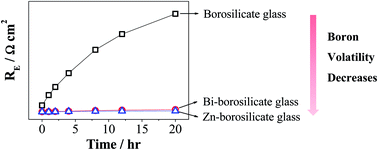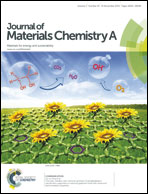New zinc and bismuth doped glass sealants with substantially suppressed boron deposition and poisoning for solid oxide fuel cells†
Abstract
Borosilicate-based glasses are the most common sealant materials for solid oxide fuel cells (SOFCs). However, boron species vaporizing from glass sealants poison and degrade the electrocatalytic activity of cathodes of SOFCs. In this study, we report the development of a new class of glass sealants based on bismuth and zinc doped borosilicates with significantly suppressed boron volatility. Doping Bi induces the [BO3] → [BO4] transition with an increased binding energy of boron, while addition of Zn leads to the formation of a boron-containing compound, Sr3B2SiO8, with significantly increased stability of boron in the glass matrix. Using La0.6Sr0.4Co0.2Fe0.8O3 (LSCF) perovskite oxide as the cathode to assess the boron deposition and poisoning, the results indicate that the polarization performance of the LSCF cathode for the O2 reduction reaction in the presence of Bi and Zn doped glass is very stable with a negligible change in the microstructure of the electrodes. In contrast, in the case of conventional borosilicate glass, boron preferentially deposits in the electrode/electrolyte region under cathodic polarization, forming primarily LaBO3, disintegrating the perovskite structure and significantly degrading the electrochemical activity of the LSCF cathodes. Doping Bi or Zn remarkably reduces the boron volatility of the glass, thus effectively inhibiting the poisoning of boron species on the microstructure and electrocatalytic activity of SOFC cathodes such as LSCF. The present results demonstrate for the first time that the Bi and Zn doping is the most effective strategy to minimize the boron poisoning from the source by suppressing the boron vaporization of borosilicate-based glass sealant materials.


 Please wait while we load your content...
Please wait while we load your content...